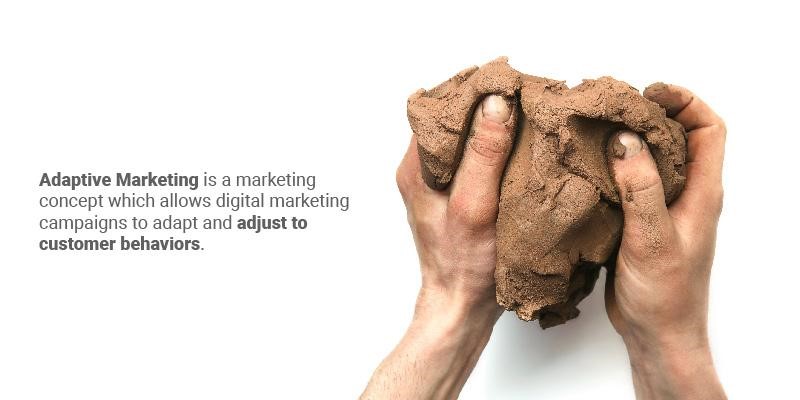In the 2002 Steve Spielberg film Minority Report, there is a science fiction depiction of future advertisements. As our main character walks through a mall, eye scanners read his identity and barrage him with a series of personalized ads based on his information, purchase history, and more.
Nearly 20 years ago, this seemed much more far fetched. Today, marketing campaigns that adapt to the consumer’s history and individual needs are the norm. We are rapidly approaching a time when the majority of marketing tracks and responds to customer behaviors. Minority Report was not far from the mark minus holograms and eye scanners.
Adaptive marketing is a modern interpretation of this concept. Brands store, track, and analyze customer information in order to adapt their marketing materials to customers’ individual needs. Today, we will explore how adaptive marketing can be used for brand growth.
What is Adaptive Marketing?

Let’s take a step back. Adaptive marketing is not some intrusive, privacy shattering business practice. Instead, it is a marketing concept which allows digital marketing campaigns to adapt and adjust to customer behaviors.
In the example given by Minority Report, the adaptive actions by the brands were all based on individual customer demographics and buying history. While this is certainly a type of adaptive marketing, it is not the only application.
Adaptive marketing can also be used to try new marketing materials and adjust on the fly. Adaptation isn’t just about reaction, it is about brands taking the opportunity to roll out new material and to use customer response to hone in on what works best.
Adaptive Marketing Focuses on Customer Needs

Modern customers expect their favorite brands to get to know them. Imagine logging on to your favorite online clothing website and the site has forgotten your past orders. Want to re-order the same set of socks because you love them? Too bad, out of luck. The majority of customers would find this situation unacceptable in today’s world.
Now imagine receiving an email from that same clothing website. The top of the screen lists new fashions related to your previous purchases which are available in your size and within the color palette you prefer. Towards the bottom of the page, there is an option to re-order more socks in the correct size and style.
The second example is adaptive marketing in action. The clothing company here has stored customer data and baked that information directly into their marketing efforts. Each customer will receive customized marketing content adapted specifically to his or her individual needs.
Why Adaptive Marketing is Important in the Digital Age

In the digital age, shopping has become less of an experience and more of a convenience. While this may not be true to all industries, what remains largely true as a rule is that customers don’t like having their time wasted.
Digital marketing campaigns recognize this by offering custom tailored, adaptive marketing materials to fit into the many “micro-moments” which customers have each day. Micro-moments are brief customer interactions with technology such as checking social media and reading new emails.
Since customer attention spans have shortened and advertising volume has increased, the importance of cutting straight to the chase in marketing has never been greater. Adaptive marketing solves this problem by delivering curated branding content straight to the end user in a way that will grab and hold their attention.
Flexibility as a Digital Marketing Strategy
The best laid plans of mice and men go awry, and the best laid marketing strategies can be rendered useless by a shift in the marketplace. Flexibility and adaptive marketing are near essential in today’s business world. Customer expectation and brand perception can change at the drop of the hat, and digital marketing strategy must be able to quickly and effectively react.
Of course, adaptive marketing and flexible digital marketing practices cannot solve every problem. There are certain aspects of your marketing campaign which should remain flexible while others should stay the course.
Adaptive marketing relies on the following staying flexible and adaptable:
- SEO strategy
- Marketing content based on customer demographics
- Which products and/or services take center stage
- Prices, offers, and other details
However, your branding should remain consistent for the most part. Avoid changing the following so that your branding can remain strong, recognizable, and dependable:
- Brand message
- Brand identity and brand personality
- Brand logo, style, graphic design, etc.
- Any other motifs which are associated with your brand
When a customer sees your branding material, he or she should know it is from your brand. An adaptive marketing strategy should be applied only to the details, never to the core message.
Clock Tower Insight Adaptive Marketing Strategies for Brand Growth
Clock Tower Insight is proud to work with a wide range of B2C and B2B industries, including retail, CPG, food service, and advertising organizations. We believe in using powerful, cutting edge research to offer brand-specific insights.
With this insight, we work with brands to turn the data into actionable information, and eventually into business growth. Our services include brand positioning, customer experience management, and much more.
Learn more about how Clock Tower Insight can help your business today.

